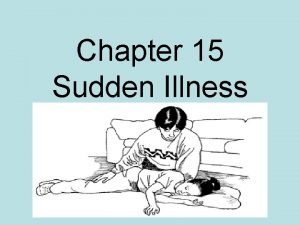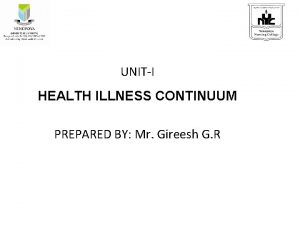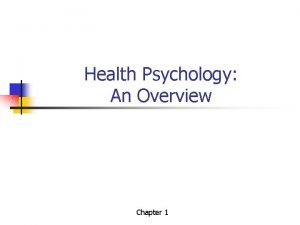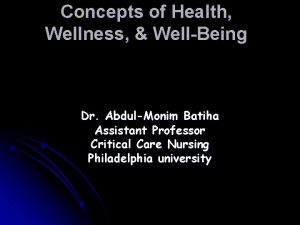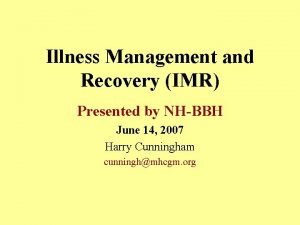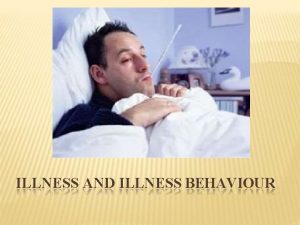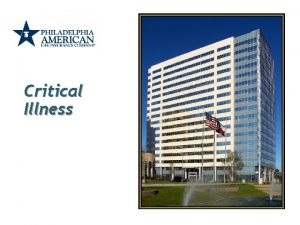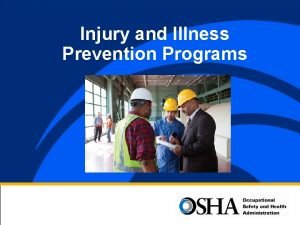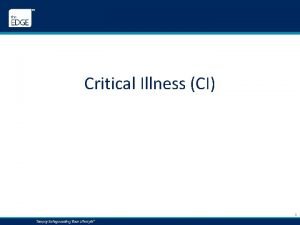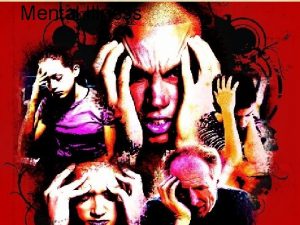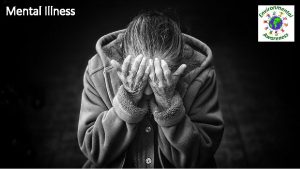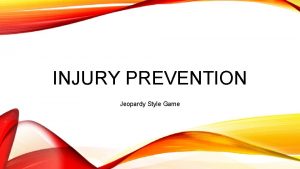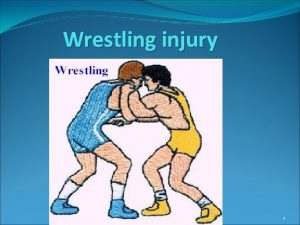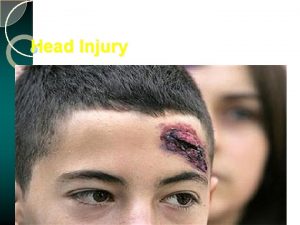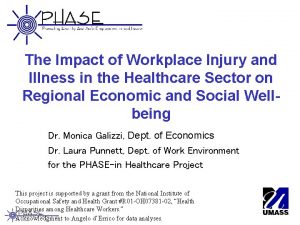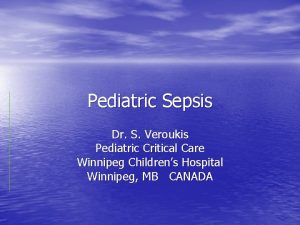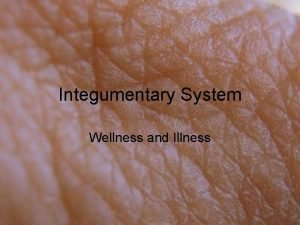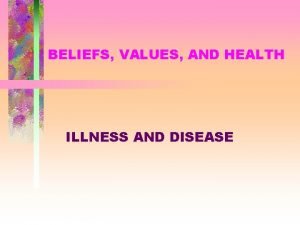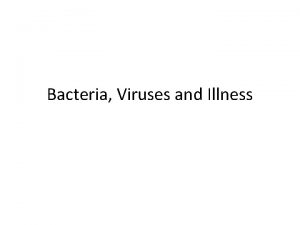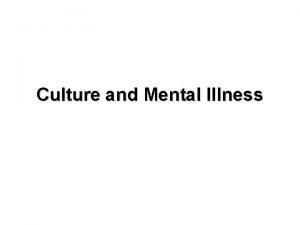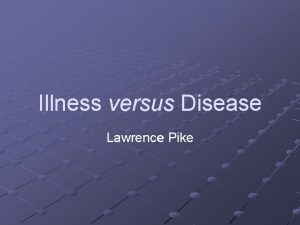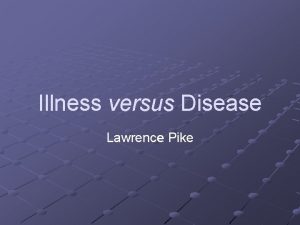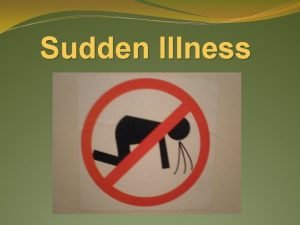The Impact of Pediatric Critical Illness and Injury




































- Slides: 36

The Impact of Pediatric Critical Illness and Injury on Families: A Systematic Literature Review 1 Lihinie de Almeida, Susan Ly, Marysia Shudy 08/01/05 National Institutes of Health United States Department of Health and Human Services Bethesda, MD

Rationale Audience: • Patients, families, and health care personnel of the PICU Purpose: • Elucidate: – – – Stressors Needs Social Impact Psychosocial Impact Health impact • Present coping strategies of families with children in the • • PICU Reveal deficiencies within the current research Encourage provision of further interventions

Methods • National competition for summer scholarship selected 3 first-year medical students from all AAMC accredited medical institutions • Literature search using – National Library of Medicine – Library at the National Institutes of Health • Supervision by pediatric intensivist (C. E. N. ) and pediatric pulmonologist (C. L. )

Pub. Med Keywords: – Child – Illness – Impact – Families – Chronic – Critical – Experience – Trauma – Siblings – Effects – Pediatric – Care – Parents – PICU – Teenagers

Exposure to Critical Care Medicine Practice: – Children’s National Medical Center PICU • Bi-weekly Rounds Research: – Naval Medical Research Center Lab • Combat Casualty Care: Resuscitative Medicine • Weekly Lab

Stressors Procedures • Injections • Running IV fluids • Drawing blood • Giving oxygen • Putting tubes in child • Respirator • Bandage changes 7 Sights & Sounds • Constant bright lights • Sudden alarms

Stressors Child’s Appearance • Tubes in child • Bruises, cuts, incisions • Covered eyes • Child restricted to bed • Invasive equipment 9 Child’s Behavior and Emotions • Whining • Demanding behavior • Inactivity • Withdrawal • Unresponsiveness • Loss of bowel or bladder control

Stressors Staff Communication • Explanations too fast • Technical jargon • Talking about matters not relating to child • Too much information • Lack of emotional support or encouragement • Sudden dismissal Staff Behavior • Rushing • Inappropriate joking or laughing • Indifference towards child or parents

Stressors Parental Role Deprivation • Separation from child for extended periods • Incapacity to care for child • Inability to hold child • Restricted visiting hours • Failure to console child

Stress Vulnerability Factors • Higher socioeconomic status • An incomplete family situation – Single-parent households • • • A higher number of preceding life events A lower functional status A longer duration of hospitalization for the child *all resulted in higher PDS scores

Psychological Parent Identified • Know how child is being treated • Feeling of hope • Assurance • Have questions answered honestly • Know what is being done for child • Feel needed by child • Feel hospital personnel care about child • Know prognosis • Receive information daily • Communication Needs

Physical • Personal needs – Food and drink – Sleep and rest – Exercise and activity • • • Visit at any time Have a place to stay near child Talk to doctor daily Help with child’s physical care Cry Allow siblings to be near child

Social • Finances • Transportation • Religious support • School support • Family togetherness • Care for other children

Overview of • prospective • single-sample studies • sample Studies sizes from 7 -189 Impact families • psychological, physical, social impact • Outcome Measures 54 • • • PRISM PSS: PICU FACES-III

Overview • Sample Information: – – – Caucasian Two-parent households families Mothers • Statistics on PICU children: – – Age ranged from 2 days-25 years old 10 =PICU for the first time 8 = unexpected PICU admissions Trauma, cardiovascular, respiratory, and neurological

Psychological Impact • Mothers: – – – – apprehensive panicked guilty factors of illness severity and time after discharge decreased mental health with potential chronicity perceive a worse illness severity befriending hospital staff being close to the child • Fathers: – more likely to use expertise of staff – higher catecholamine levels when child is in the PICU

Psychological Impact • Parents: – higher levels of stress and increased catecholamine levels for parents of younger kids – greater emotional support for parents of children with lifethreatening illnesses • Grandparents: – stressed – concerned

Psychological Impact • Siblings: – – – feelings of depression fear for own health withdrawing from injured child isolation and unimportance resentment or rivalry

Physical Impact Family members experienced physical symptoms as a result of having a child with a critical illness. • Parents/Caregivers: – worsened physical health – feeling numbness – physically sick • Family Unit: – – sleep nutrition increased infections physical fatigue – tired – headaches – anxiety 57

Social Impact • Family functioning and adaptability: – – – pre-injury functioning greater concerns about the child’s future Illness severity • Social support: – family stress – cognitive appraisal • Parents and caregivers’ functioning decreased: – lack of time spent with family – financial costs • No change in family functioning and cohesion

Social Impact • Marital adjustment: – increase in marital conflict – Increase in divorce – no significant difference in marital adjustment

Social Impact • Mothers: – decrease in family cohesion after PICU admission – adaptability related to: • illness severity • location • length of intubation period

Social Impact • Fathers: – family cohesion: • illness severity • length of stay – adaptability: • length of stay – stress: • PICU procedures • financial concerns

Social Impact • Siblings: – poorer self-concept related to the patient’s functional outcome – negative impact on behavior – poorer relationships with peers in school

Coping Behavioral and cognitive efforts utilized to manage internal and external stressors: • emotion-focused: positive reappraisal, selfcontrol, escape-avoidance, acceptance of responsibility, distancing • problem-focused: social support, problem solving, confrontive expression

Factors that Affect Coping • • Age Gender Ethnicity SES Past crisis Environment Support

Familial Coping Two levels of interactions: • how a family internally deals with difficulties between its members • how a family deals externally with problems in the environment Ideally, families cope at both levels.

Coping is enhanced when: • • Near child often Participate in child care Child treated as an individual Accurate information Reassurance Daily updates Social support

Interventions Twenty-five studies aimed to relieve the impact of critical care upon pediatric patients and their families.

Interventions • Meal vouchers • Sleeping • • • accommodations Transportation/parking Laundry facilities Telephones

Interventions • • • Informative letter Home visit Hospital film Web page updated daily Animal-assisted therapy

Interventions • Group sessions • Creating Opportunities for Parent Empowerment (COPE) – Audiotape – Literature – Activities • Nursing Mutual Participation Model of Care (NMPMC) – Open ended questions – Participation – Goals

PICU team 83 81 82 84 85 86

Further Research 87 • • • Long-term outcomes Non-maternal members Non-nuclear families SES implications Demographics Sample size

Limitations • Comprehensive but not exhaustive • 8 week time span for literature search • Different outcome measures among studies

Thank You! 88 89
 Critical semi critical and non critical instruments
Critical semi critical and non critical instruments Semi critical instruments in dentistry
Semi critical instruments in dentistry Intentional injury examples
Intentional injury examples Trustmark critical illness
Trustmark critical illness Compare non-critical readers with critical readers.
Compare non-critical readers with critical readers. Chapter 20 mental health and mental illness
Chapter 20 mental health and mental illness Name 5 sudden illness.
Name 5 sudden illness. John travis illness wellness continuum
John travis illness wellness continuum Illness and wellness continuum
Illness and wellness continuum Health illness continuum
Health illness continuum Nhbbh
Nhbbh Hình ảnh bộ gõ cơ thể búng tay
Hình ảnh bộ gõ cơ thể búng tay Frameset trong html5
Frameset trong html5 Bổ thể
Bổ thể Tỉ lệ cơ thể trẻ em
Tỉ lệ cơ thể trẻ em Voi kéo gỗ như thế nào
Voi kéo gỗ như thế nào Tư thế worm breton
Tư thế worm breton Chúa yêu trần thế
Chúa yêu trần thế Các môn thể thao bắt đầu bằng từ đua
Các môn thể thao bắt đầu bằng từ đua Thế nào là hệ số cao nhất
Thế nào là hệ số cao nhất Các châu lục và đại dương trên thế giới
Các châu lục và đại dương trên thế giới Công thức tính độ biến thiên đông lượng
Công thức tính độ biến thiên đông lượng Trời xanh đây là của chúng ta thể thơ
Trời xanh đây là của chúng ta thể thơ Mật thư anh em như thể tay chân
Mật thư anh em như thể tay chân Phép trừ bù
Phép trừ bù Phản ứng thế ankan
Phản ứng thế ankan Các châu lục và đại dương trên thế giới
Các châu lục và đại dương trên thế giới Thể thơ truyền thống
Thể thơ truyền thống Quá trình desamine hóa có thể tạo ra
Quá trình desamine hóa có thể tạo ra Một số thể thơ truyền thống
Một số thể thơ truyền thống Cái miệng bé xinh thế chỉ nói điều hay thôi
Cái miệng bé xinh thế chỉ nói điều hay thôi Vẽ hình chiếu vuông góc của vật thể sau
Vẽ hình chiếu vuông góc của vật thể sau Biện pháp chống mỏi cơ
Biện pháp chống mỏi cơ đặc điểm cơ thể của người tối cổ
đặc điểm cơ thể của người tối cổ Thế nào là giọng cùng tên?
Thế nào là giọng cùng tên? Vẽ hình chiếu đứng bằng cạnh của vật thể
Vẽ hình chiếu đứng bằng cạnh của vật thể Phối cảnh
Phối cảnh






